How to use Facebook Lead Ads to personalize your email campaigns
In this recipe, we’ll show you how to use Facebook Lead Ads to determine what a user is interested in—directly from the user themself. Then, we’ll show you how to use that data to drive revenue through personalized email campaigns.
Jun 2, 2020
By Calvin French-Owen
Facebook has an ad unit called a Lead Ad. It lets you collect information from people who view the ad via a form. You can ask them for anything, like their email address, interests, and phone number. The best part about it is, when they share information with you, they’re doing so willingly. (There’s no creepy third-party data involved here.)
The magic comes when you run these ads against your existing leads and customers. You can collect additional data that can then be used to personalize their experience down the line. The more you know about your audience, the more you can improve product recommendations, marketing messages, and sales conversion.
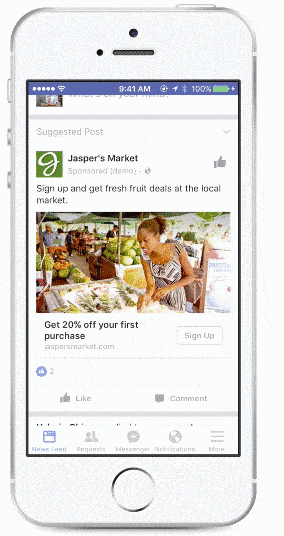
When you collect data through a Lead Ad, you can send it to your CRM or anywhere else. This is where Segment comes in: without any code, you can use Segment Connections to connect Facebook Lead Ads data to other customer data tools automatically.
This makes it much easier to analyze customers, segment them, and act on your new data.
For this recipe, we’ll take advantage of Lead Ads to identify which product or product category your users are most interested in. Then we’ll send them tailored email campaigns exciting them about that product category.
Step 1: Capture user intent data via Facebook Lead Ads
Let’s say you own an equipment and sporting goods store, and that you stock over 5,000 SKUs. With so many products, it’s difficult to know the exact product a customer might be interested in.
With Lead Ads, you can capture the purchase intent data you need to be able to deliver a personalized experience. Ask users all your relevant questions. Also ask for their contact information:
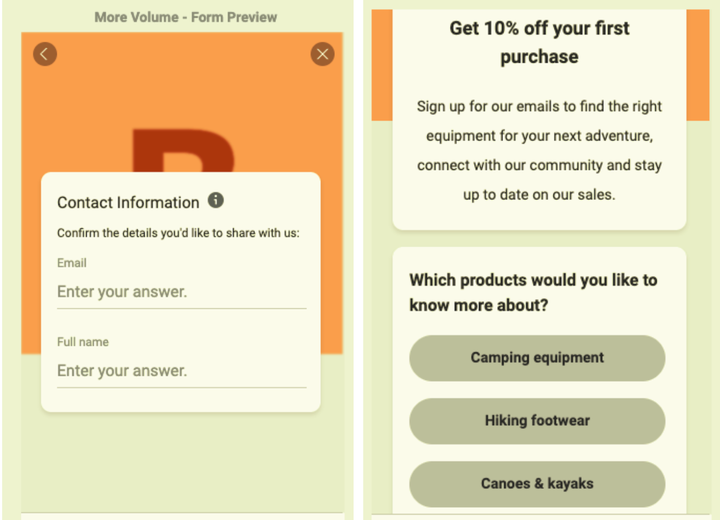
Step 2: Connect Facebook Leads Ads to Segment
You need to share the user data that you collect with Facebook Lead Ads in order to use that rich intent and interest data elsewhere. You’ll do that through Segment using the Facebook Lead Ads source.
Here’s how you set up your Facebook Lead Ads source:

Set up a Facebook Lead Ad campaign by following the steps here.
Search for “Facebook Lead Ads” within the Sources Catalog then confirm by clicking Connect.
Give the source a name. The name will be a label used in Segment’s interface. The nickname can be whatever you like, but we recommend sticking to something that reflects the source itself, such as Facebook Lead Ads or Facebook Lead Ads Prod.
Click Create And Continue then Connect to OAuth into Facebook.
Select which accounts to sync (you can change this selection later).
Verify that your leads are syncing into Segment. You can test this by sending a test lead to Segment using Facebook’s Lead Ad testing tool. Click on Segment’s Debugger to see a live stream of Facebook’s incoming data. You should see your leads come in as Identify calls.
Depending on what you’ve asked people to fill out on your Facebook Lead Ad, you can collect and analyze that information within Segment:
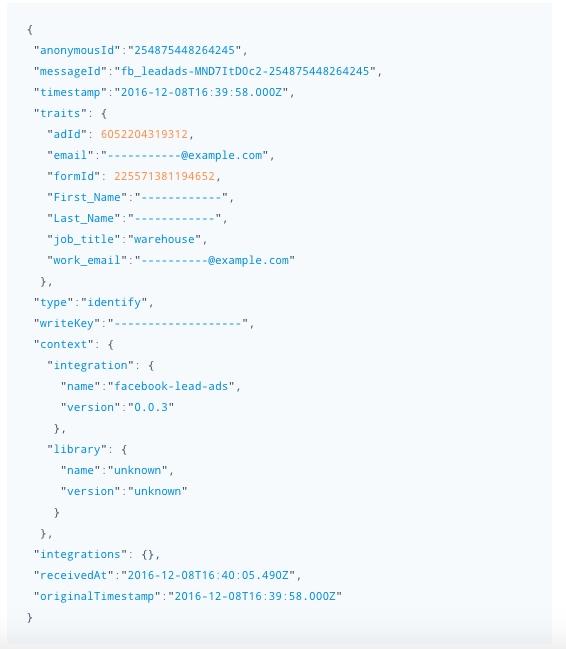
Not a Segment user yet? Get started with a demo here 👉
Step 3: Send intent data to your email marketing tool
Once you’ve added Facebook Lead Ads as a Source, you can connect it to a number of Destinations. In the above example, we used MailChimp, but there are multiple Destinations that can be connected to Facebook Lead Ads, including other email marketing tools, CRM, and analytics, and more.
That means you’ll be able to use that intent data to personalize a customer’s experience in a number of different channels, including your email campaigns. It’s an incredible personalization opportunity when a user tells you that they’re considering a specific product.
To connect a Destination, select Facebook Lead Ads in your Sources, then click Add Destination and search for your preferred platform. You can see the full list of destinations in the Segment Catalog.
Once you’ve configured your settings, Segment will automatically pull data from Facebook Lead Ads and send it to the destination. Within the email platform, you’ll be able to view and segment users based on their responses, and assign drip campaigns based on their interests.
You can also use Segment to help analyze the data you pull from your Facebook Lead Ads. You can use Segment to ETL data from Facebook Lead Ads directly to your data warehouse. Simply authenticate your Facebook Ads account and Segment will start pulling the relevant data and queuing it for your next data warehouse load.
Step 4: Develop personalized drip campaigns
Now that your Facebook Lead Ads data is available in your email tool, it’s time to build out campaigns.
Within your email tool, it’ll help you automatically filter segments of customers based on their Lead Ad answers. That means you can easily create email drip campaigns that cater to a customer’s specific interests.
In the above example, you might decide that users who are interested in canoes and kayaks (which you’re unable to ship) would prefer to receive information about shopping in-store.
In fact, let’s take a step back to add another layer to our Lead Ad example above: If a user selects Canoes & kayaks, you can use their selection to reveal a Conditional Answer Set: a set of questions with answers that change based on how someone answered a previous question. For example, if and only if the user selects the Canoes & kayaks option, they’ll then be prompted to answer one more question:
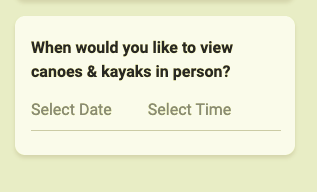
Knowing that the user is interested in a specific type of product and has availability on a certain date allows you to usher them further down the funnel to make deeper commitments — such as hopping on a sales call with you or buying an item for in-store or curbside pickup.
Plus, when Segment pulls this data and sends it to your chosen email marketing tool, you can segment users even further based not only on their interests but also on their purchase intent.
The possibilities for sending targeted content based on Lead Ad answers go far beyond email campaigns. Think on-site popups, customized ads, direct mail, and more.
Examples of what you can ask users for
Ask leads when they’re looking to make a purchase. Using Lead Ads, you can customers about when they are looking to make a purchasing decision. This data is useful for future retargeting efforts and email outreach campaigns. If someone is looking to purchase 3 months from now, schedule your ads to run in the month leading up to it to be top of mind when they’re ready to move forward.
Customize your product experience based on customer surveys. Analytics tools can only tell you so much about a customer and their needs and wants. It’s valuable to blend quantitative and qualitative data about a customer to get a more holistic understanding of how to better serve them. Use Lead Ads to conduct customer surveys on your existing subscribers to inform future product enhancements.
Check-in with free trial users. Regularly check-in with users that are on your free trial to make sure they’re getting the full value of your product. Run Lead Ads to them with a questionnaire asking how they’re enjoying the product and if there are any issues they’re running into. That way, you can address those issues during their free trial period, increasing the likelihood that they convert to paid.
Growth advice for Facebook Lead Ads
Be sure to very quickly follow up with anyone who opts into your Facebook Lead Ads. These leads can go stale quickly — and forget they even filled it out.
In addition to collecting data on existing users, Facebook Lead Ads can be used to collect data on new users to bring them into your funnel. You can offer “lead magnets” to entice them with downloadable resources in exchange for the email address. Plus, because Facebook tracks all this activity, you can easily retarget them afterward with more Facebook ads.
Like any ad campaign, you should A/B test Facebook Lead Ads to determine which variant results in the highest quality leads at the lowest costs. Try one variant just asking for an email address and another with a higher friction intake form to see how they perform. Maybe the ladder weeds out low quality leads and gives you more actionable data you need to make the sale.
To check our more personalization strategies like this, check out our Recipes page.
(P.S. If you want help with anything covered in this post, we've got you covered! Get started with Segment here 👉)
The State of Personalization 2023
Our annual look at how attitudes, preferences, and experiences with personalization have evolved over the past year.
Get the report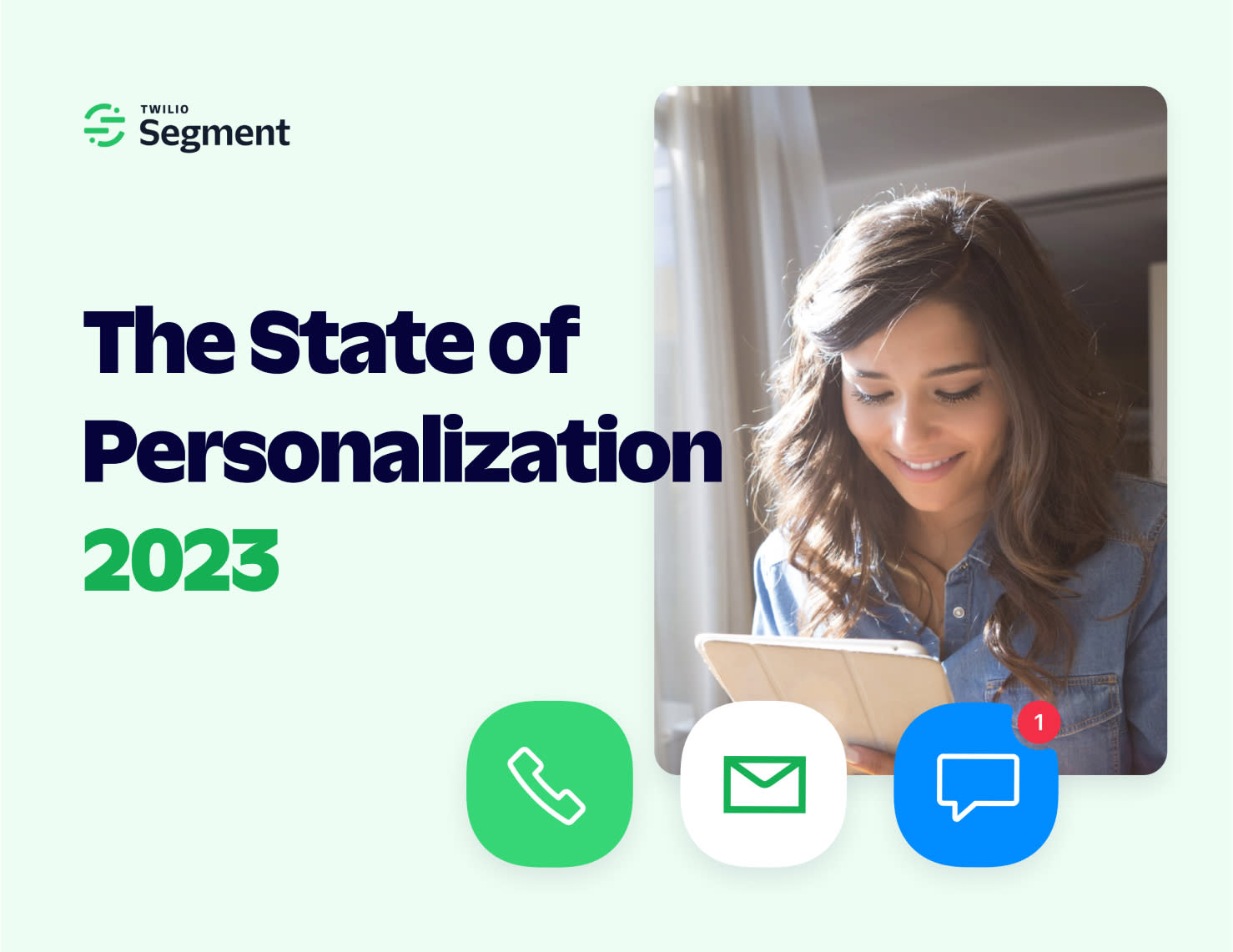
The State of Personalization 2023
Our annual look at how attitudes, preferences, and experiences with personalization have evolved over the past year.
Get the report
Share article
Recommended articles
How to accelerate time-to-value with a personalized customer onboarding campaign
To help businesses reach time-to-value faster, this blog explores how tools like Twilio Segment can be used to customize onboarding to activate users immediately, optimize engagement with real-time audiences, and utilize NPS for deeper customer insights.
Introducing Segment Community: A central hub to connect, learn, share and innovate
Dive into Segment's vibrant customer community, where you can connect with peers, gain exclusive insights, and elevate your success with expert guidance and resources!
Using ClickHouse to count unique users at scale
By implementing semantic sharding and optimizing filtering and grouping with ClickHouse, we transformed query times from minutes to seconds, ensuring efficient handling of high-volume journeys in production while paving the way for future enhancements.